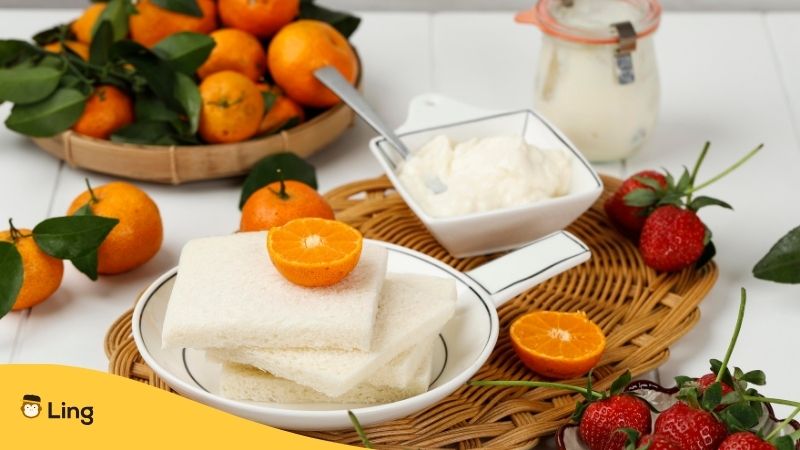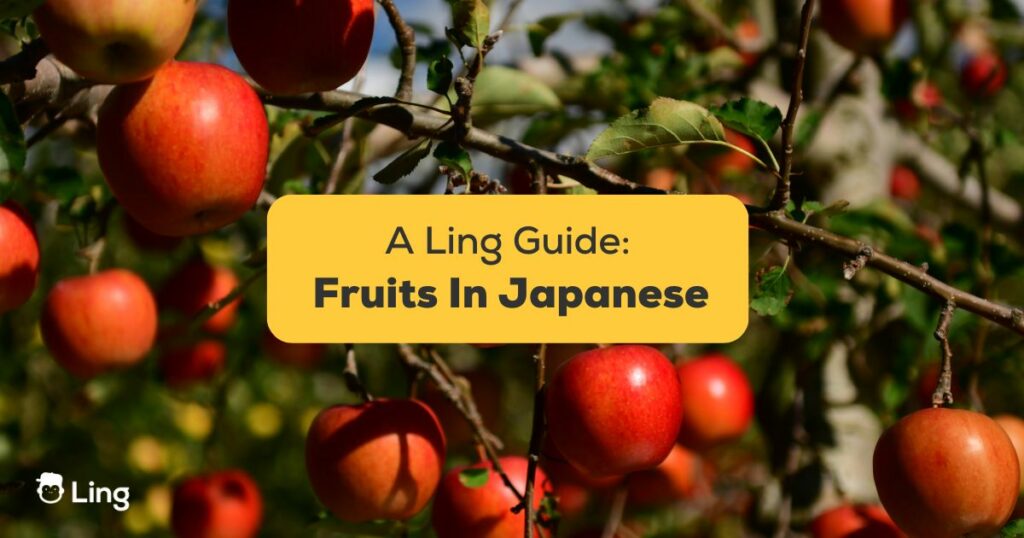Eager to boost your Japanese language skills beyond “konnichiwa” and counting to ten? Learning about くだもの (kudamono), or fruits in Japanese, is a yummy way to grow your knowledge of the language. Even if a trip to Japan is still just a someday dream, armed with fruit terms, you’ll be prepared when your chance to visit this incredible country finally comes.
In this post, I’ll teach you the Japanese words for over 20 tempting types of fruit. We’re talking sweet Asian oranges, juicy seedless grapes straight from the vine, and strawberries so flawless they look like they were grown with tender loving care alone. But wait, there’s more! I’ll also share some sentence patterns in the Japanese language so you can shop at local markets and grocery stores with confidence.
Japanese Fruits
Fruits are kind of a big deal in Japan. We’re talking premium produce elevated to an art form: fruits with luxury status! It’s not just because of their bursting, perfect sweetness, either. Everything from how fruits get gifted to the work that goes into achieving specific shapes shows how prized they are in Japanese food culture.
Scroll social media long enough, and you’ll likely see videos of people reacting to the eye-popping price tags on fancy Japanese fruits as a result. Like, hello, square watermelons priced at over $100 because they stack oh-so-neatly in fridges? What fruit sorcery is this?!
Indeed, between the country’s climate challenges, and the intricate cultivation methods passed down through generations of farmers, growing delectable fruits in Japan costs a pretty yen. But oh baby, that dedicated care and attention shows in every juicy bite!
It’s not just today’s hip social media influencers that fawn over Japanese fruits. We’re talking coveted since WAY back – fruits were serious status symbols fit to gift powerful warlords in medieval times! Samurai offered fruits with a ceremony to impress shoguns and nobility.
These days, exquisite fruits still get whipped out to commemorate occasions or woo clients because, well, some traditions stick around! Especially tastier-than-thou ones. From elegantly wrapped tropical fruits as New Year’s presents to perfect summer berries that spell romance in Japan, fruit equals big deals.
Now that I’ve gotten you good and hungry want to bite into the names of iconic Japanese fruits?

8 Most Common Japanese Fruits
Japanese Oranges – Mikan・みかん
Mikan are mouthwatering sweet oranges integral not just to Japanese cuisine, but the culture. Grown nationwide with prime crops from Ehime and Shizuoka, these wallet-friendly fruits are a staple in households and markets nearly year-round.
Tantalizingly juicy, mikan gets sliced up by the dozens for snacking, juicing, preserving into jam, or used as auspicious New Year’s decor. Some Japanese supermarkets even sell mikan in mochi form as mikan daifuku – a sweet rice cake stuffed with real orange slices!
Japanese Peaches – Momo・桃
Aside form their decadent taste, japanese peaches pop up across classic literature and folk stories like “Momotaro” – featuring a courageous boy birthed from a peach! Though a relatively recent variety, modern momo now star in desserts like decadent momo parfaits or as the fruit accompaniment to salty foods to balance flavors.
Japanese Strawberries – Ichigo・苺
In Japan, delicate strawberries thrive best in the mild cool of winter rather than summer humidity. And the celebrity royalty? Fukuoka’s Amaou, dubbed “the king of strawberries,” and is considered one of the top luxury fruits. And if you’re planning to actually gift it, prepare your wallets because the gift-giving varieties can cost more than $100!
Japanese Pear – Nashi・梨
At first glance, the round nashi fruit easily tricks you into mistaking it for a green apple! But bite into that taut golden skin, and its dense, juicy pear flesh gives it away. Locals eagerly await nashi’s crisp autumn season to enjoy them freshly picked in bento lunches, salads, or thinly sliced sashimi-style over rice. Some shops also use the pears for shakes, icy pops, and mochi!
Japanese Persimmon – Kaki・柿
Glossy orange persimmons have thrived in Japan since ancient times – featuring heavily in poetry, art, and tradition as an iconic fall bounty. Their sweet, almost cinnamon-spiced jelly flesh comes enclosed in a tough, bitter skin needing softening before enjoyment. Locals wait keenly through winter for that first tender bite of beloved kaki, either fresh, dried into chewy preserves, baked in cakes, or even distilled into liquor!
Japanese Plum – Ume・梅
From over 100 varieties, Japanese ume plums are best known for transforming into the country’s trademark pickled products. Popular umeboshi are ume cured in shiso leaf and salt, lending addictively sour-salty pops pairing perfectly with rice. Similarly, honey-floral umeshu liqueur infuses ume flavors into a sweet-tipped spirit.
Japanese Watermelon – Suika・スイカ
By June, aromatic sweet suika chunks fill market fruit stands as locals eagerly grab refreshing slices for bento lunches and beach picnics. Prices range from premium for gifted fruit, but affordable pre-cut sika is never hard to find. Beyond raw eating, creative cooks transform melon into sorbets, cocktails like suika sake, and even shakes.
Japanese Muskmelon – Meron・メロン
Want another melon that’s just cheaper? The Japanese melon is the best way to go! While several regions boast coveted crops, prized melons hail from Hokkaido and Ibaraki best – namely, the iconic Yubari King cantaloupe. Locals savor them simply chilled in slices or as decadent parfaits and highballs to celebrate the fleeting warmer months in regal style.

Vocabulary For Fruits In Japanese
Armed with these key terms below, you’ll be ready to navigate markets and grocery stores, order desserts, and chat with locals about their fruit recommendations. Trust me, just a little vocab goes a long way towards fuller cultural experiences.
| English | Japanese Script | Japanese Pronunciation |
|---|---|---|
| Apple | りんご | Ringo |
| Banana | バナナ | Banana |
| Grape | ぶどう | Budou |
| Lemon | レモン | Remon |
| Pineapple | パイナップル | Painappuru |
| Mango | マンゴー | Mangō |
| Kiwi | キウイ | Kiwī |
| Cherry | さくらんぼ | Sakuranbo |
| Papaya | パパイア | Papaia |
| Lychee | ライチ | Raichi |
| Guava | グアバ | Guaba |
| Dragonfruit | ドラゴンフルーツ | Doragonfurūtsu |
| Grapefruit | グレープフルーツ | Gurēpufurūtsu |
| Tangerine | みかん | Mikan |
| Pomegranate | ざくろ | Zakuro |
| Fig | いちじく | Ichijiku |
| Date | デーツ | Dētsu |
| Coconut | ココナッツ | Kokonattsu |
| Avocado | アボカド | Abokado |
| Blueberry | ブルーベリー | Burūberī |
| Raspberry | ラズベリー | Razuberī |
| Blackberry | ブラックベリー | Burakkuberī |
| Cranberry | クランベリー | Kuranberī |

How To Say Your Favorite Fruit In Japanese
You just bit into incredible fruit in Japan, and now gotta rave about it! Well, try this basic Japanese structure:
わたしの好きな果物は______です。 (Watashi no sukina kudamono wa _____ desu.)
Breaking it down word for word:
- Watashi = “I/me”
- No = possessive particle
- Sukina = “favorite”
- Kudamono = “fruit”
- Wa = topic marker particle
- Desu = to be/”is”
So, it directly translates to: “My favorite fruit is ________.” Easy, right? Now, you can easily express your love for juicy cherries, melons, mandarins, or exotic mangos in authentic beginner Japanese.
Learn Japanese Today!
I hope this post showed you why fruits deserve their celebrity status in Japan and equipped you with tons of new vocab to try exotic produce for yourself!
But hey! Mastering fruit terms is just the first bite into the incredibly rich world of Japanese vocabulary. Whether you’re prepping for upcoming travel or aspire to fluency someday, you’ll need an awesome app to build well-rounded language skills over time.
That’s why I highly recommend Ling to all aspiring Japanese speakers!
The Ling app utilizes simple 5-minute lessons to help you gain command of reading, writing, listening, and conversation. Over a million language learners swear by the app’s fun, quick daily lessons based on science-backed methods like flashcards and speech recognition. Give it a try now!



































































